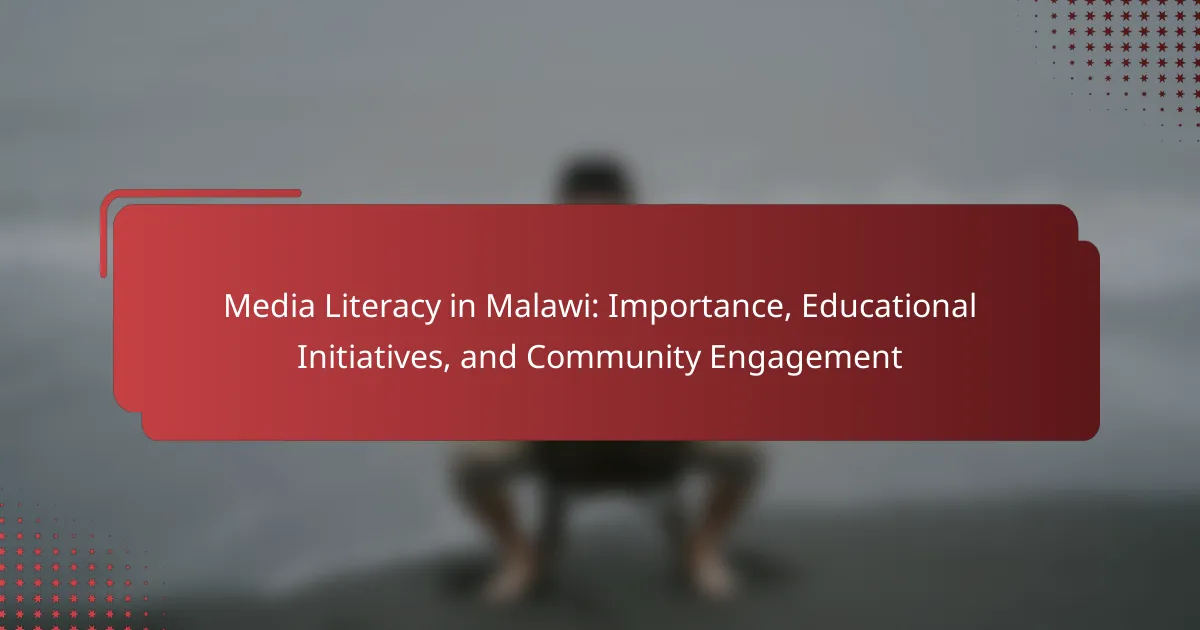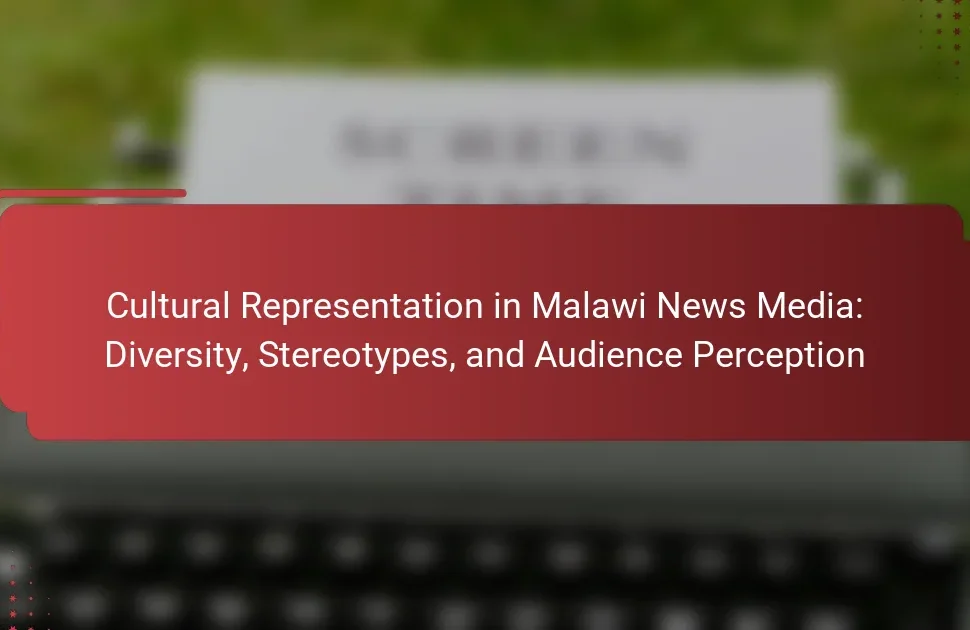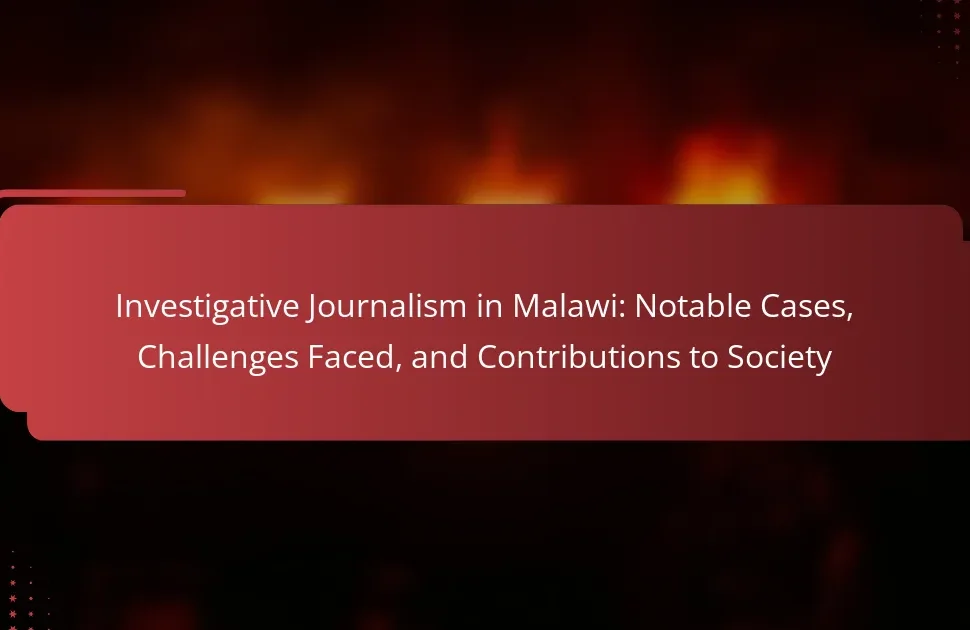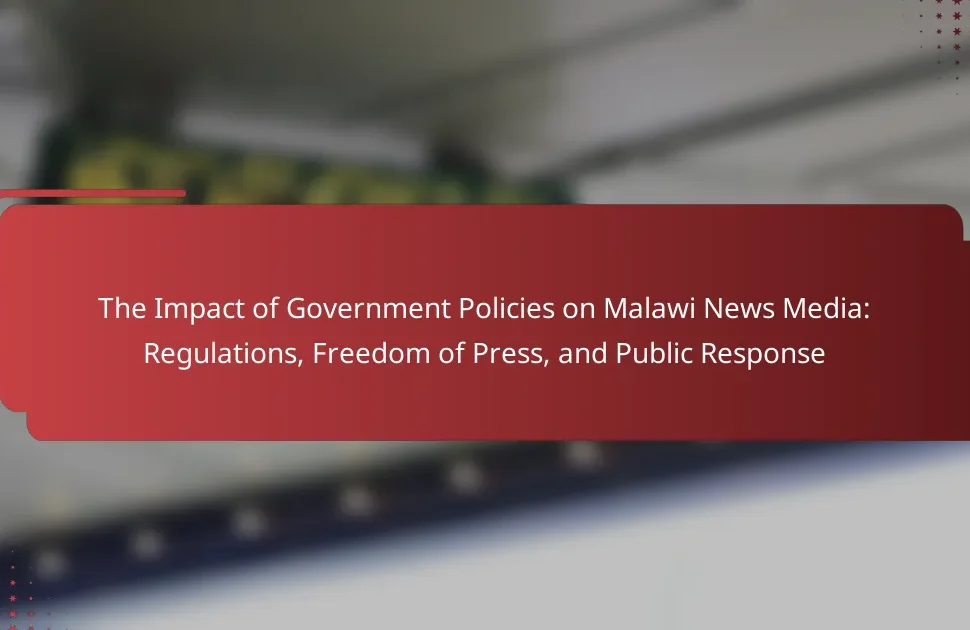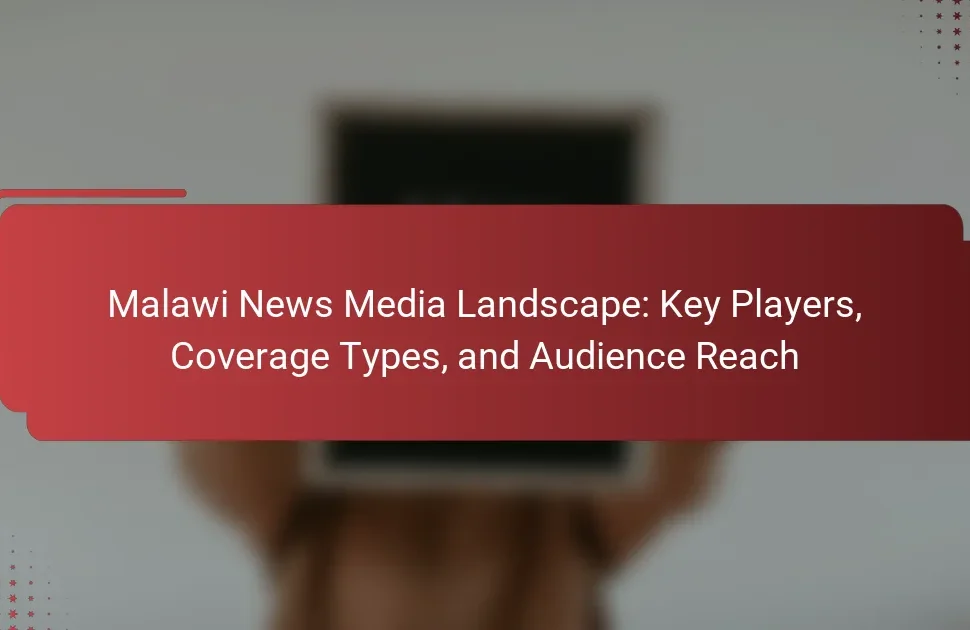Media literacy is the ability to access, analyze, evaluate, and create various forms of media, and it plays a vital role in Malawi for fostering critical thinking and informed citizenship. With increasing media consumption, citizens face challenges in distinguishing credible information from misinformation. Educational initiatives by the Malawi Communications Regulatory Authority (MACRA), NGOs, and the Ministry of Education focus on enhancing media literacy through training workshops and curriculum integration. Community engagement further supports these efforts by promoting collaborative learning and resource sharing, ultimately empowering individuals to critically assess media content and contribute to a more informed society.
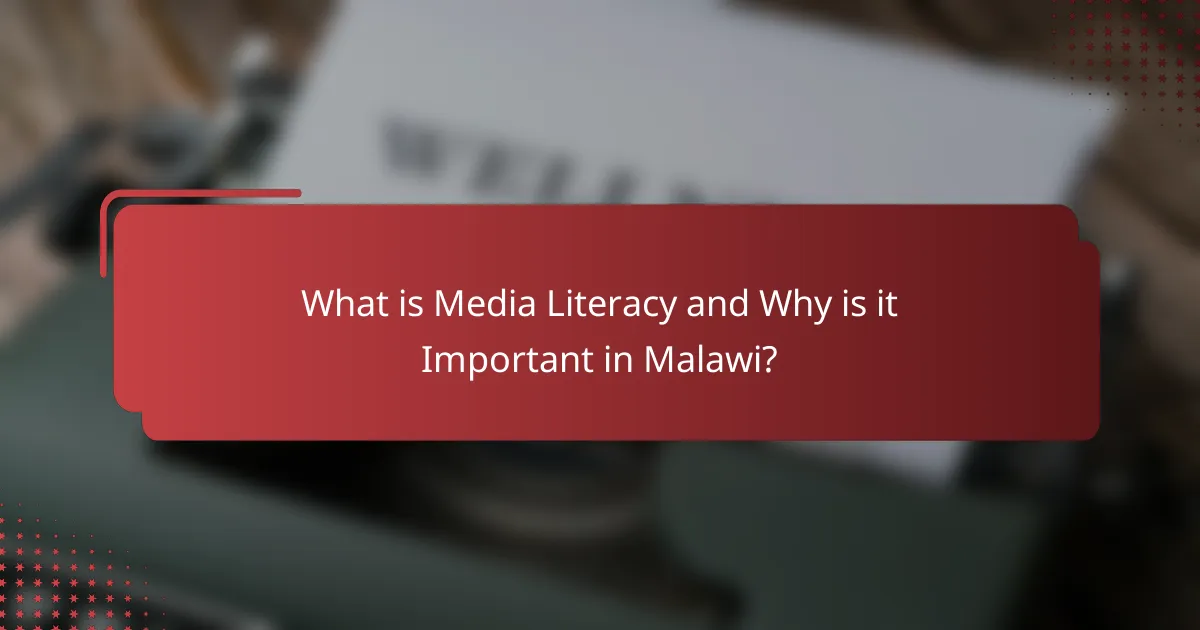
What is Media Literacy and Why is it Important in Malawi?
Media literacy is the ability to access, analyze, evaluate, and create media in various forms. In Malawi, it is crucial for fostering critical thinking and informed citizenship. Media literacy empowers individuals to discern credible information from misinformation. This is particularly important in a country where media influence is growing rapidly. According to a 2020 report by the Malawi Communications Regulatory Authority, media consumption has increased significantly. As a result, citizens face challenges in distinguishing reliable news sources. Enhanced media literacy can promote democratic participation and social cohesion. It also supports the development of a more informed public, which is essential for national development.
How does media literacy impact society in Malawi?
Media literacy significantly impacts society in Malawi by enhancing critical thinking and informed decision-making. It empowers individuals to analyze and evaluate media messages critically. This skill helps combat misinformation and promotes democratic participation. Improved media literacy contributes to better civic engagement among citizens. Studies show that increased media literacy correlates with higher voter turnout and civic involvement. Furthermore, it fosters social cohesion by encouraging dialogue and understanding among diverse communities. Educational initiatives focused on media literacy are essential for developing these skills. Overall, media literacy plays a crucial role in shaping an informed and engaged society in Malawi.
What are the key components of media literacy?
The key components of media literacy include the ability to access, analyze, evaluate, and create media content. Access refers to the capability to find and use various media sources. Analysis involves critically examining media messages and understanding their purpose. Evaluation requires assessing the credibility and reliability of media sources. Creation encompasses producing media content responsibly and ethically. These components help individuals navigate the complex media landscape effectively. Research shows that media literacy skills contribute to informed citizenship and enhance critical thinking abilities.
How does media literacy influence critical thinking skills?
Media literacy enhances critical thinking skills by enabling individuals to analyze and evaluate information effectively. It teaches people to discern credible sources from unreliable ones. This skill is essential in today’s information-rich environment. Research indicates that individuals with strong media literacy skills are better at questioning the validity of information. They can identify biases and understand different perspectives. A study by the National Association for Media Literacy Education shows that media literacy education improves students’ analytical skills. This improvement is linked to better academic performance and informed decision-making. Thus, media literacy directly contributes to the development of critical thinking abilities.
Why is media literacy essential for Malawian youth?
Media literacy is essential for Malawian youth because it empowers them to critically analyze information. In an age of rapid digital communication, youth encounter various media messages daily. Understanding these messages helps them discern credible information from misinformation. Research indicates that media literacy fosters critical thinking skills. It also encourages responsible media consumption and production. Furthermore, it prepares youth for active participation in democratic processes. According to the UNESCO report on media literacy, informed youth contribute positively to society. Overall, media literacy equips Malawian youth with necessary skills for navigating a complex media landscape.
What role does media literacy play in shaping informed citizens?
Media literacy plays a crucial role in shaping informed citizens by equipping them with the skills to critically analyze information. This ability helps individuals discern credible sources from misinformation. Informed citizens can engage in public discourse more effectively. They are better prepared to participate in democratic processes. Studies show that media literacy education enhances critical thinking skills. For example, a report by the National Association for Media Literacy Education highlights improved decision-making among media-literate individuals. This is particularly important in a digital age filled with diverse information sources. Ultimately, media literacy fosters a more informed and engaged citizenry.
How can media literacy help combat misinformation?
Media literacy helps combat misinformation by equipping individuals with critical thinking skills. It enables people to analyze and evaluate information sources effectively. With enhanced media literacy, individuals can discern credible news from false information. Research indicates that media-literate individuals are less likely to share misinformation. A study by the Pew Research Center found that media literacy education reduces susceptibility to fake news. By fostering skepticism towards unverified claims, media literacy promotes informed decision-making. This is essential in a digital age where misinformation spreads rapidly. Ultimately, media literacy empowers communities to engage in informed discourse.
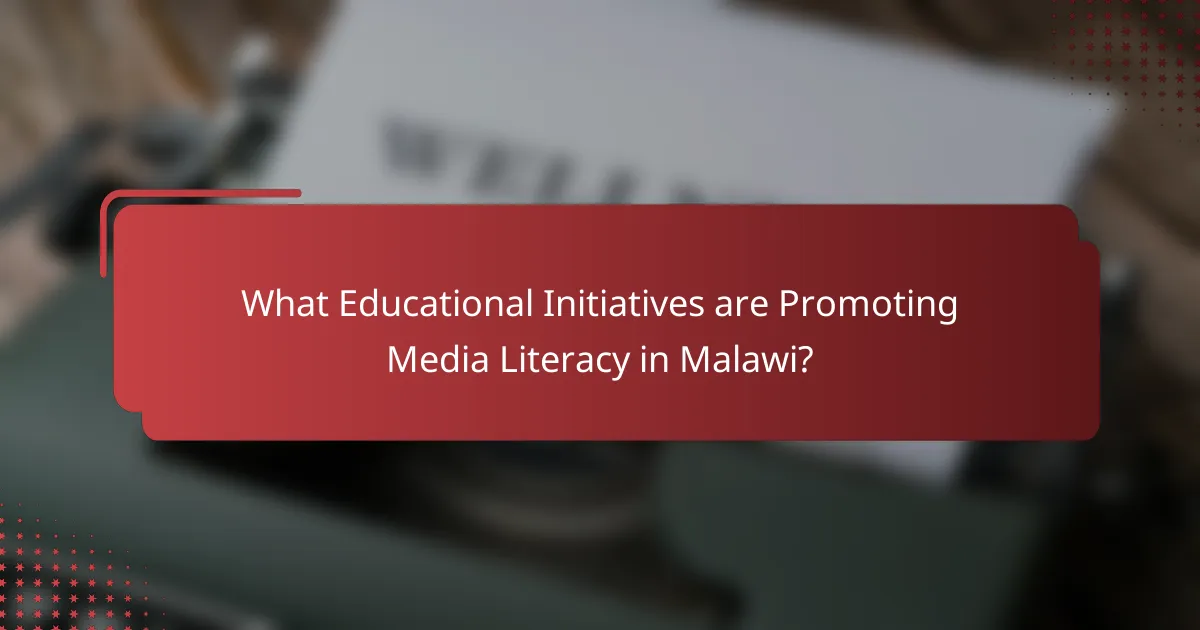
What Educational Initiatives are Promoting Media Literacy in Malawi?
Educational initiatives promoting media literacy in Malawi include programs by the Malawi Communications Regulatory Authority (MACRA) and various NGOs. MACRA has launched campaigns to educate citizens about responsible media consumption. NGOs like the Media Council of Malawi provide training workshops for teachers and students. These workshops focus on critical thinking and evaluating media sources. Additionally, the Malawi Ministry of Education has integrated media literacy into school curricula. Research shows that these initiatives have increased awareness of misinformation among students. The collaboration between government and civil society enhances the reach of these programs.
How are schools incorporating media literacy into their curricula?
Schools are incorporating media literacy into their curricula by integrating it across various subjects. Many educational institutions are developing specific media literacy programs. These programs teach students to critically analyze media messages. Schools use project-based learning to engage students in real-world media scenarios. Educators provide training on identifying misinformation and understanding media bias. Collaborative projects with local media organizations enhance practical learning experiences. Research shows that students who engage in media literacy programs perform better in critical thinking assessments. Overall, schools aim to equip students with essential skills for navigating today’s media landscape.
What specific programs are being implemented in Malawian schools?
Malawian schools are implementing several specific programs aimed at enhancing media literacy. These include the “Media Literacy Program” designed to teach students critical thinking about media content. The initiative focuses on understanding media messages and discerning credible sources. Another program is the “National Reading Program,” which incorporates media literacy into reading and comprehension skills. Additionally, the “School-Based Youth Media Clubs” encourage students to engage in media creation and analysis. These programs are supported by organizations like UNESCO and local NGOs. The goal is to equip students with skills necessary for navigating the media landscape effectively.
How are teachers trained to deliver media literacy education?
Teachers in Malawi are trained to deliver media literacy education through structured professional development programs. These programs focus on integrating media literacy into the existing curriculum. Training includes workshops, seminars, and hands-on activities. Teachers learn to analyze media content critically. They are equipped with skills to facilitate discussions on media influence. Resources include guides and toolkits specifically designed for educators. Collaboration with organizations like UNESCO enhances the training quality. Research shows that trained teachers significantly improve students’ media literacy skills.
What role do NGOs play in enhancing media literacy?
NGOs play a crucial role in enhancing media literacy. They provide educational programs that teach critical thinking skills regarding media content. These programs often target vulnerable populations, including youth and women. NGOs also create resources that help individuals understand media messages. They conduct workshops and training sessions to improve media consumption skills. Furthermore, NGOs advocate for policies that promote media literacy in schools. Research shows that communities engaged with NGOs report higher levels of media literacy. This engagement fosters informed citizens who can critically assess media information.
Which organizations are leading media literacy initiatives in Malawi?
Organizations leading media literacy initiatives in Malawi include the Malawi Communication Regulatory Authority (MACRA) and the Media Institute of Southern Africa (MISA) Malawi. MACRA focuses on promoting responsible media usage and enhancing public understanding of media content. MISA Malawi works to advocate for media freedom and support media literacy programs across the country. Both organizations contribute to improving media literacy through workshops, training sessions, and community outreach programs. Their efforts aim to empower citizens with critical thinking skills regarding media consumption.
What resources do these organizations provide to communities?
Organizations focused on media literacy in Malawi provide various resources to communities. They offer educational workshops to enhance critical thinking skills. These workshops often cover topics like identifying misinformation and understanding media influence. Additionally, they supply educational materials such as booklets and online resources. Some organizations also facilitate community discussions and forums to encourage dialogue. Access to digital tools and platforms is another resource provided. These initiatives aim to empower individuals with the skills necessary for informed media consumption. Studies show that increased media literacy leads to better community engagement and informed decision-making.
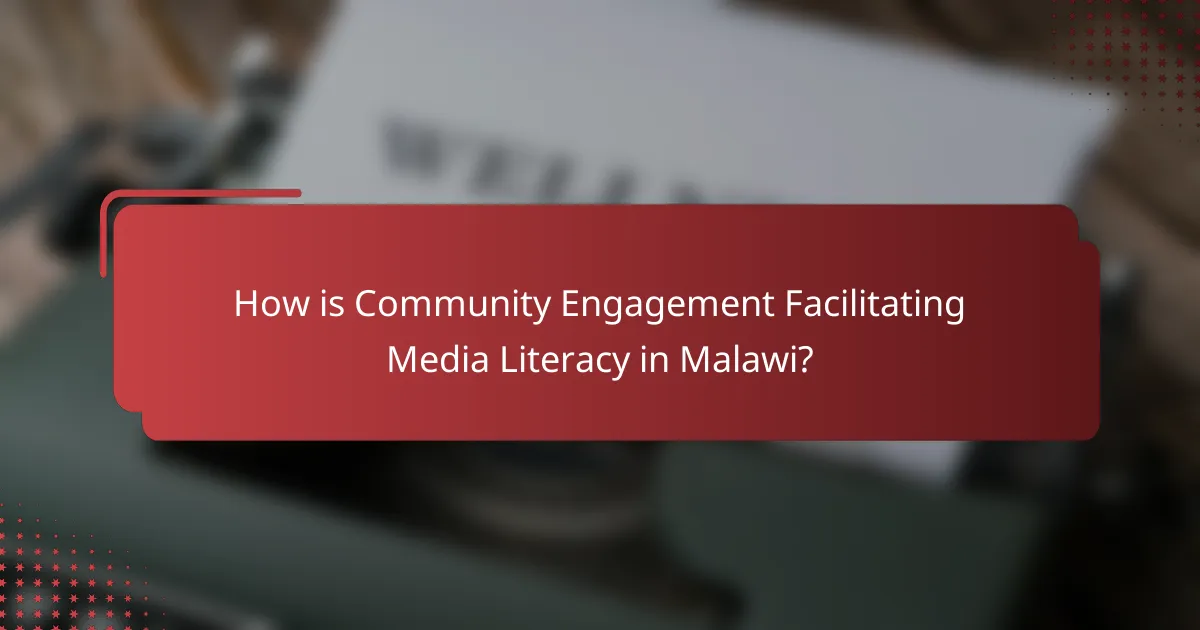
How is Community Engagement Facilitating Media Literacy in Malawi?
Community engagement is facilitating media literacy in Malawi by promoting collaborative learning and resource sharing. Local organizations and community groups are actively involved in educational initiatives. These initiatives include workshops, discussions, and training sessions focused on critical thinking and media consumption skills.
Research indicates that community-driven projects enhance understanding of media messages. For instance, programs led by organizations like the Media Institute of Southern Africa have shown increased awareness of misinformation. Engagement with local leaders helps tailor media literacy efforts to specific community needs.
Furthermore, community engagement fosters a supportive environment for dialogue about media influence. This collective approach empowers individuals to analyze and question media content effectively. Overall, community involvement significantly enhances the impact of media literacy initiatives in Malawi.
What community programs are available to promote media literacy?
Community programs available to promote media literacy in Malawi include workshops, training sessions, and partnerships with local organizations. These initiatives aim to educate individuals about critical thinking regarding media consumption. Programs often target youth and educators to enhance their media skills. For instance, the Media Council of Malawi conducts training for journalists and community leaders. Additionally, organizations like the Malawi Communications Regulatory Authority promote awareness through campaigns. Research shows that such programs significantly improve participants’ understanding of media messages. These efforts are crucial for fostering informed communities in Malawi.
How do these programs engage different age groups?
These programs engage different age groups through tailored content and interactive activities. Younger participants often experience hands-on workshops that include technology use and social media literacy. These workshops help them navigate digital spaces effectively. For adolescents, programs focus on critical thinking and analysis of media messages. They encourage discussions around media influence on their lives. Adults engage through community forums that address current media trends and misinformation. These forums provide a platform for sharing experiences and strategies. Senior participants often receive training on using digital tools for information access. This ensures they remain informed and connected. Overall, the varied approaches cater to the specific needs and interests of each age group.
What are the outcomes of community-based media literacy initiatives?
Community-based media literacy initiatives lead to improved critical thinking skills among participants. These programs enhance the ability to analyze and evaluate media messages. Participants become more informed consumers of information. Increased awareness of media influence contributes to better decision-making. Evidence shows that communities engaged in media literacy exhibit reduced misinformation. For example, a study by the Knight Foundation found that media literacy programs significantly decreased susceptibility to false information. Additionally, these initiatives foster community dialogue and collaboration. They create spaces for sharing diverse perspectives and experiences. Overall, community-based media literacy initiatives empower individuals and strengthen community resilience.
How can individuals contribute to media literacy efforts in their communities?
Individuals can contribute to media literacy efforts in their communities by organizing workshops. These workshops can teach critical evaluation of media content. They can also facilitate discussions about the impact of media on society. Creating resource materials, such as pamphlets or online guides, can further support these efforts. Volunteering at local schools to introduce media literacy programs is another effective approach. Engaging with local libraries to host media literacy events can increase community awareness. Collaborating with NGOs focused on education can amplify these initiatives. Research shows that community-led programs significantly enhance media literacy skills among participants.
What best practices can community members adopt to promote media literacy?
Community members can adopt several best practices to promote media literacy. They should engage in discussions about media content and its impact. Hosting workshops can educate individuals on identifying credible sources. Sharing resources, such as articles and videos on media literacy, helps raise awareness. Forming community groups focused on media literacy encourages collaboration and information exchange. Encouraging critical thinking about media messages is essential. Providing access to diverse media platforms allows for broader perspectives. Lastly, advocating for media literacy programs in schools can institutionalize these efforts. These practices collectively enhance media literacy within the community.
How can collaboration enhance media literacy initiatives?
Collaboration can enhance media literacy initiatives by pooling resources and expertise from various stakeholders. When schools, community organizations, and media outlets work together, they create comprehensive programs. These programs can address diverse learning needs and reach wider audiences. Collaborative efforts can also lead to the sharing of best practices and innovative strategies. For example, joint workshops can provide hands-on experience with media tools. Research indicates that collaborative learning environments improve critical thinking skills. A study by the International Communication Association found that partnerships significantly boost engagement in media literacy activities. By combining efforts, stakeholders can create more impactful and sustainable media literacy initiatives.
What are the challenges facing media literacy efforts in Malawi?
Media literacy efforts in Malawi face several challenges. Limited access to technology hinders engagement with digital content. Many communities lack reliable internet connectivity. Educational resources on media literacy are often insufficient. There is a scarcity of trained educators in this field. Cultural attitudes towards media can also discourage critical analysis. Additionally, misinformation spreads easily due to low media literacy levels. These factors collectively impede the effectiveness of media literacy initiatives in the country.
How do socio-economic factors affect media literacy initiatives?
Socio-economic factors significantly influence media literacy initiatives. Communities with higher income levels often have better access to technology and educational resources. This access enables more effective participation in media literacy programs. Conversely, low-income communities may lack the necessary infrastructure for such initiatives. Limited access to the internet and digital devices hampers engagement in media literacy efforts.
Additionally, socio-economic status affects educational attainment. Higher education levels correlate with improved media literacy skills. Research indicates that individuals with lower socio-economic backgrounds may struggle to critically analyze media content. This lack of critical thinking skills can perpetuate misinformation.
In Malawi, socio-economic disparities impact the reach and effectiveness of media literacy programs. For example, urban areas may have more resources compared to rural regions. This imbalance can lead to unequal opportunities for media literacy education. Addressing these socio-economic challenges is crucial for enhancing media literacy across all communities.
What strategies can be employed to overcome these challenges?
Strategies to overcome challenges in media literacy in Malawi include enhancing educational curricula, promoting community workshops, and leveraging technology. Integrating media literacy into school programs can provide foundational skills. Community workshops can engage diverse groups and raise awareness about media consumption. Utilizing mobile technology can reach remote areas, increasing accessibility to information. Collaborations with local organizations can strengthen outreach efforts. These strategies are supported by studies indicating that targeted education improves critical thinking in media contexts.
Media literacy in Malawi is defined as the ability to access, analyze, evaluate, and create media, which is vital for fostering critical thinking and informed citizenship in a rapidly evolving media landscape. The article explores the significance of media literacy for societal engagement, particularly among youth, and highlights various educational initiatives and community programs aimed at enhancing these skills. It discusses the role of NGOs, the integration of media literacy into school curricula, and the challenges posed by socio-economic factors. Additionally, the article outlines strategies for overcoming these challenges to promote informed decision-making and combat misinformation effectively.
